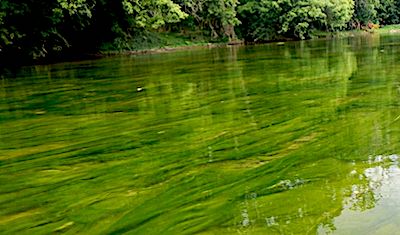
~ Press release issued by the Virginia Department of Health
STRASBURG, Sept. 17 — Effective immediately, the Virginia Department of Health (VDH) has lifted the recreational advisory due to a harmful algae bloom (HAB) on the North Fork (NF) of the Shenandoah River in Shenandoah and Warren counties from Chapman’s Landing to Riverton. This river segment (about 52.5 miles) was placed under a recreational advisory on Aug. 10 due to widespread algal mats, which contained both cyanobacteria cells and toxins at elevated levels.
Weekly observations at numerous sites along the river where algal mats were previously widespread which resulted in the recreational advisory being issued, indicate these mats are no longer visible. Confirmatory water samples collected Sept. 14 indicate no cyanobacteria cells were present and toxins at or below detection limits, well below those that pose a human health risk. The HAB status report for the NF Shenandoah River has been updated along with the Algal Bloom Map for reference of the prior advisory areas, samples and observation sites.
VDH would like the public to be aware that while the bloom appears to have dissipated based on recent observations and testing, it is possible for algal blooms to reappear when there is adequate sunlight, nutrients and warmer temperatures to make conditions favorable for algal growth. Most algae are harmless, however, some may produce irritating compounds or toxins if ingested. Because it is difficult to tell the difference, VDH advises everyone to avoid discolored water, scums or mat material that are green or bluish-green because they are more likely to contain toxins. The algae blooms, which occurred in this area, may produce mats along the river bottom that may then detach, float on the water surface, or accumulate along downstream shorelines.
The North Fork of the Shenandoah River serves as the drinking water source for the Towns of Strasburg and Woodstock, and the City of Winchester. All three localities took every precaution to prevent impacts to drinking water, including routine testing for cyanotoxins and optimization of treatment processes for cyanotoxin removal. Anatoxin-a, the main toxin present in this HAB, has not been detected in the Town of Strasburg’s raw (untreated) or finished drinking water since August 12, and toxin levels remained below VDH and Environmental Protection Agency (EPA) health advisory levels at all times during this event. Anatoxin-a was below detectable levels in the Town of Woodstock and the City of Winchester’s raw and finished drinking water for the duration of the HAB. Drinking water remains safe to drink and use in all three localities.
Harmful algae can cause skin rash and gastrointestinal illnesses, such as upset stomach, nausea, vomiting and diarrhea. Some toxins in algae blooms can be fatal to dogs and other animals when ingested. If you or your animals experience any negative health effects after swimming in or near an algal bloom, seek medical or veterinary care promptly.
Whenever recreating in natural waterbodies follow these healthy water habits:
- Avoid contact with any area of the river if you observe algae or algal mats to be present.
- Humans and pets should never consume water or material from a natural waterbody because this water is not treated water and is not suitable for consumption.
- Notify VDH of an algae bloom or fish kill, use the online HAB report form.
- If you suspect you or your animal experienced health-related effects following contact with a bloom, contact the Virginia Harmful Algal Bloom Hotline at (888) 238-6154.
The Virginia Harmful Algal Bloom Task Force (VDH, Virginia Department of Environmental Quality, Old Dominion University Phytoplankton lab, and Virginia Institute of Marine Science) respond to bloom events to protect public health during the recreational season of May through October. The majority of algal blooms will dissipate when temperatures and sunlight are reduced in fall and winter months.
For more information about harmful algae blooms and the HAB Task Force, visit www.SwimHealthyVA.com.
•••
RELATED ARTICLES
Harmful algae bloom advisory expanded for North Fork of Shenandoah River
Nature Notebook: The summer smallmouth smorgasboard
Shenandoah National Park reopens streams to fishing



Be the first to comment